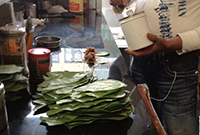Medildos, Medillionaires, anal, insane, brave, whatever you want to call us – from the outside, Medill life seems like a crazy mass of students asking for a quote. Yes, while an interview is most likely what we seek, journalism majors’ unique curriculum makes “college” different from the traditional sense of the word.
Medill makes you cold-call strangers, take the El to class and use outside class time to meet with an interviewee where you may have to ask some uncomfortable questions. While trying to report on homelessness in Evanston, I faced many painfully blank stares of people not wanting a thing to do with me. Welcome to Medill.
When on deadline for a 7 to 9 p.m. reporting class in the dead of winter, things may look dismal. I’m not going to lie, the weekly deadlines of 201-1 Reporting and Writing did expand the stress scale to a new level, but this class was an introduction to what Medill students could expect from their courses: human interaction. While all of college is human interaction, this is Medill’s curriculum.
Studying in the library for three hours is one typical option for any student to crunch through assignments, but most of our “study” time is composed of interviewing, documenting and working with people – and the result is more than just practice for the future.

Medill students have the opportunity to learn about the places and people we study alongside. It is not every day that your homework brings you to places where you can see drag queen costumes or eat traditional Indian Paan.
Of course, Chicago is open to all students, but Medill takes you to some unexpected corners. For example, one time I found myself in the heart of the Chicago neighborhood Little Village, attending a “taco festival” comprised mostly of locals to report for one of my final projects. Medill’s forced cultural engagement comes with hard deadlines and hours of editing – but in a place as exciting as Chicago, I’ll take it.
Beyond experiencing different cultures and places, journalism majors get to know (or are forced to know, depending on how you look at it) the story behind these people, places and situations. Not only do Medill students take in experiences as they are, we also go deeper into the “why” and “how” of them.
While that may be more work, I believe it adds value to what we encounter in life – beyond just reporting for the story. When I went to an antique shop, I saw the current relics of time that any visitor would see, but I was able to find out more. I learned about the building’s history as a place where Louis Armstrong used to play and where people now sometimes practice Santeria. Who knew? I didn’t.
From a careerist standpoint, what’s great about Medill is we have the opportunity to practice what we hope to do in our futures. The imaginary wall separating college and your career doesn’t exist with journalism.
But for me, Medill is about the conversations as much as it is the bylines. While I appreciate its career value, I’m more grateful for the experiences the school has afforded me. While it can feel like we have a second job to school, these assignments give us the opportunity to contact heads of companies, locals and friends – all the people journalists would contact while actually “on the job.”
For many Medill students, one’s time is very dependent on others. Putting plans on hold for a last-minute interview or event comes with the territory. Sometimes one’s schedule isn't really one’s own schedule, but then again that’s life – exactly what journalism is all about.